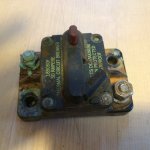Corrosion can travel inside wire jacket !
I had considered opening another thread, or addressing the issue here, and Chromer's post made my decision easy.... Absolutely you have to get back to good wire, but in cleaning up the wire strands you tend to loose the tinning, if the wire had the creeping corrosion.
I have run into this issue of corrosion along the wire, to the extent that I have completely re-wired boats which were 20 years old. Lots of wire in a Cal 46!
1. Wire should be
tinned, marine grade, and AWG (not SAE (automotive). American Wire gauge is 6 to 10% larger than SAE gauge! All tables for wire runs on boats are AWG.
2. All wires should be properly crimped with marine quality fittings (meaning tinned, and coated with plastic covers--best with adhesive heat shrink tubing, to form a waterproof seal at each swaged joint.
3. If the swage (crimp) fittings are not adhesive shrink tube equipt, they should be covered with either Adhesive heat shrink tubing, or they should be covered with regular heat shrink tubing, and then the ends coated with liquid tape.
4. I feel that all crimps in the #10 to #20 AGW, should be made with a high quality
ratchet crimper--there are some cheaper ones, which do not have the proper dies for AWG fittings.
5. For the large fittings, where it is not possible to seal the ends, with covering, is where I have used solder--this achieves two goals--if I have a question about the
"hit the hammer" type of swagger's effectiveness, than it makes an excellent electrical and mechanical connection. Potter Water's points are well taken, but ABYC does address this issue, as I cited earlier. There is support of these wires, and there is over 1.5 x diameter amount of solder. This is sweated in with a torch, not a soldering iron on the large lugs. This seals both ends. Then the fitting is also covered with heat shrink tubing and supported properly.
6. Definitely
dielectric grease, and Corrosion block are used on fittings to prevent corrosion with ring or spade terminals.
7. For
small fittings, (#20 to #24) which will usually be NMEA connections between radio and GPS for AIS etc. There are 3 choices:
A. Scotchlok Connectors--Although made for solid wires, they also work with solid wires, and no stripping of insulation is necessary. There is a dielectric silicone (I believe) fluid in the connector. Easy crimp. And then I put liquid tape over the entrance to give extra support, and wrap with tape.
B. Use a terminal block, with screws--and spray this with corrosion block--have to strip the wire.
C. Solder the wires, and cover with good length of adhesive shrink wrap to give support--and then use some supporting sheath material, like spiral wrap.
Sunbeam mentions the large jaw type of crimper. These are good for fast production large crimps. I have Similar type of compound jaw crimpers for Nicropress fittings on my sailboats (along with both bolt and cable cutters). The problem with these are that the specific model Sunbeam mentions is 25" long and weight close to 6#--difficult to get into corners where you may have to make swages. This is why I prefer the hydraulic Swaggers for the larger fittings. A good crimp basically fuses the wire and fitting, with many lbs of pressure.




